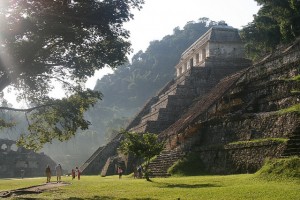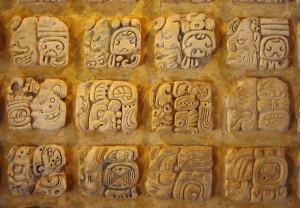6 Mar 2012
Rise and fall of the Maya civilization
 The Maya civilization is always good for a headline in the National Geographic magazine. It is commonly associated with mysterious hieroglyphs, monumental buildings and magic sunken cities, lost in the rain forest. Their ancient archaeological sites are spectacular, their pyramids in the rain forest are monumental, and the fall of their civilization is mysterious. How can an ancient civilization like this simply dissolve and collapse?
The Maya civilization is always good for a headline in the National Geographic magazine. It is commonly associated with mysterious hieroglyphs, monumental buildings and magic sunken cities, lost in the rain forest. Their ancient archaeological sites are spectacular, their pyramids in the rain forest are monumental, and the fall of their civilization is mysterious. How can an ancient civilization like this simply dissolve and collapse?
Jared Diamond mentions five factors for the collapse of the Maya civilization in chapter 5 of his book “Collapse: How Societies Choose to Fail or Succeed” (2005). He identifies the following points: population growth outstripping available resources, deforestation and erosion, increased fighting and endemic warfare, drought and mismanagement by shortsighted leaders. Considering multiple societies, he made a general 5 point framework check list of factors which determine if a society will fail in general:
- environmental problems
- climate change
- hostile neighbors
- friendly trade partners
- the society’s responses to its environmental problems
The last factor is perhaps the most important: the society’s responses to its environmental problems determines if it is able to adapt to environmental issues or not. A good response can turn around and save the situation. A wrong or missing response, i.e. the failure to adapt to environmental issues, can be the crucial factor which leads to collapse. If the attention of the leaders, as Jared argues, is only focused “on their short-term concerns of enriching themselves, waging wars, erecting monuments, competing with each other, and extracting enough food from the peasants to support all those activities” then a collapse is not surprising.
Modern researchers and scholars have confirmed this point of view. They proposed a number of factors which contributed to the fall and collapse of the ancient Maya civilization including mismanagement, poor leadership, militarism, overpopulation, exploitation of the working population, social turmoil, environmental damage, deforestation, soil erosion, famines, epidemies, and extended drought. Michael D. Coe (2011) emphasizes 3 major factors: endemic warfare, overpopulation and accompanying environmental collapse and severe drought. Sharer and Traxler (2006) argues that these factors were responsible for the decline of the divine kingship model and the breakdown of centralized authority. The most important factor was perhaps that people got tired of their society and their leaders. After an extended drought up to 9 years, no divine king was able to convince people he will be able to influence the rain god Chaac and let it rain, even if his sacrifices become larger, and his rituals wilder.
Despite all amazing accomplishments of the Maya they were not advanced enough to master the challenges of an urban society and environment. In the years of the decline, system and government were no longer adapted to the mounting challenges of society and environment. The Maya civilization collapsed because it was no longer well adapted to the environment. Originally, as Arthur Demarest notices (2004), the true secret of the Maya civilization was the successful adaptation to the complex rain forest environment, for example by raised fields, terracing and “swidden” farming. The decentralized, locally controlled adaptation to local conditions was the most successful strategy. The experiments with large conquest states ruled by divine kings apparently failed. What we see at the ruins of Tikal, Calakmul and Caracol are failures on a grand scale. The leaders or the ruling class failed to protect their people from drought and war, they failed to nourish and feed their people. They failed because their states were no longer adapted to the environment:
- drought, deforestation, exploitation: not well adapted to the natural environment
- hostility, warfare: not well adapted to cultural environment (i.e. neighbors and other city states)
These two points correspond to 4 of 5 points from Jared Diamnond’s list. The relationship to the environment was broken, the society was not well adapted to (1) environmental problems and (2) climate change. A society which causes constant environmental damage like soil erosion and deforestation by exploitation of non-renewable resources and overpopulation is certainly not well adapted to the complex and fragile environment of the rain forest, especially in times of longer drought. It is like a species which destroys the own habitat. The relationship to neighbors was also broken or badly damaged, the society was not well adapted to (3) hostile and (4) friendly neighbors. A city state based on endemic, destructive warfare is not well adapted to an environment which mostly consists of other city states. A defensive instead of an offensive strategy would have been better for hostile neighbors, and peaceful trade better for friendly neighbors. If a society fails to adapt to all these important environmental issues, then a collapse is inevitable if the pressure increases, even if the writing system is the most advanced one of the whole continent. A writing system which is only used to glorify the leaders on monumental buildings may cause awe, but it will not save the society from collapse.

A society, organization or civilization can collapse, dissolve or vanish if the people simply no longer want to be a part of it. Collapse starts if the negative emotions of the people like fear and disgust towards the group and the divine leader are stronger than the positive ones like awe and joy. Emergence starts if positive emotions are stronger than the negative ones. Spectacular monuments can contribute to both. First their greatness led to rapture and fame (the emergence of the civilization), later to ruin and shame (the collapse of the civilization), and centuries later to awe and money (the emergence of tourism). Thus monuments can lead to ruin or rapture. It depends on their use.
Every society and social group is based on sacrifices, the members must sacrifice their time, their money, their ideas, their work, or other resources they own. It makes of course a difference if the leader sacrifies himself, if the leader makes sacrifices, or if the leader sacrifices members of society. In open-minded and voluntary cultures, everyone makes a little sacrifice, in autocratic empires or dictatorships the dictator tends to sacrifice the own people (during wars or by killing heretic members). If open-minded cultures turn into brutal autocratic empires that torture and sacrifice their members, people don’t want to be member of this system anymore and the system starts to dissolve. This can be the end of civilization. If people abandon their city in a city-state they leave their civilization behind, and the civilization collapses.
In the IT industry, it is common that the question “how is it possible the system does not work” often turns during debugging into the question “how could it ever worked in the first place”. Maybe it is similar with the civilization of the ancient Maya: the question “How is it possible it broke down” may turn into the question “how could it lasted so long in the first place”.
There are some striking similarities to the rise and fall of civilizations in ancient Europe at the same time. Both worlds started with hieroglyphic writing systems, built temples and pyramids, and started to develop a higher civilization, but also produced imperialistic conquest states and empires. In a sense, the Greek city states are to the ancient Romans what the ancient Maya have been to the Aztecs: a set of independent city states which inherited their culture from earlier precursors and which were involved in constant wars against each other. The Greek temples look like Egyptian ones, and they inherited the writing system from the Phoenicians. The stepped temple pyramids of the Maya look like the ones in Teotihuacan, and they inherited their writing system from the Olmecs and Zapotecs. Both Maya and Greeks developed in turn a culture which later civilizations adopted and changed.
It looks like the monumental buildings are remains of an imperialistic “phase”. Imperialism seems to spread like a wave or disease from one area to another. Once an area has been infected with “imperialism”, it seems to be immune against it:
- Ancient Egypt » Greek » Macedonia » Roman empire
- Teotihuacan » Maya » Chichen Itza » Aztecs
We tend to admire the size and the strength of historic empires, the empire of Teotihuacan, the Roman empire, the Aztec empire, etc., but are inclined to forget how extremely brutal these empires have been. We tend to admire their monumental buildings, but forgot that they were also monumental failures: buildings of cultures who drowned in warfare, imperialism and violence.
References
Books
* Robert J. Sharer with Loa P. Traxler, “The Ancient Maya”, Stanford Univ. Press, 2006
* Arthur Demarest, “Ancient Maya”, Cambridge Univ. Press, 2004
* Michael D. Coe, “The Maya” (8th edition), Thames & Hudson, 2011
* Jared Diamond, “Collapse: How Societies Choose to Fail or Succeed”, Viking Press, 2005
Links
Wikipedia links for Maya Civilization, Maya Script and Classic Maya Collapse , for Jared Diamond’s book Collapse: How Societies choose to fail or survive, and for the ancient Maya cities Palenque, Tikal and Chichen Itza
(The picture of the Palenque ruins which shows the Temple of Inscriptions containing the tomb of Pacal is from Flickr user Carlos Adampol. Palenque, Tikal and Chichen Itza are the most famous Maya cities. The picture of the Maya Glyphs is from Wikipedia.)

[…] to the fall of maya civilization, which failed to adapt to their environment, DEC failed to adapt to their changing environment and […]
CAS-Group Blog » Blog Archive » Rise and Fall of the Digital Equipment Corporation
April 14th, 2012 at 3:37 pmpermalink